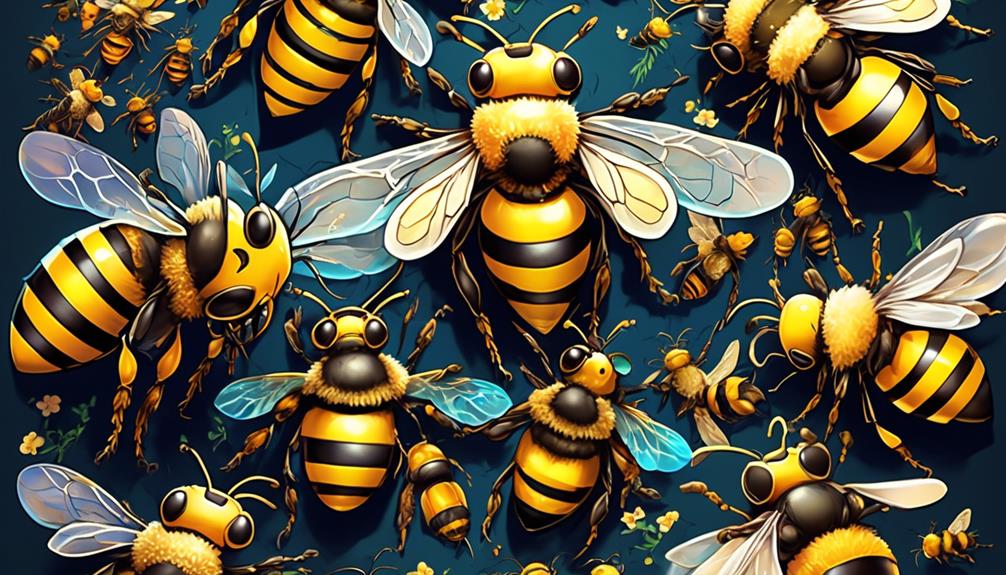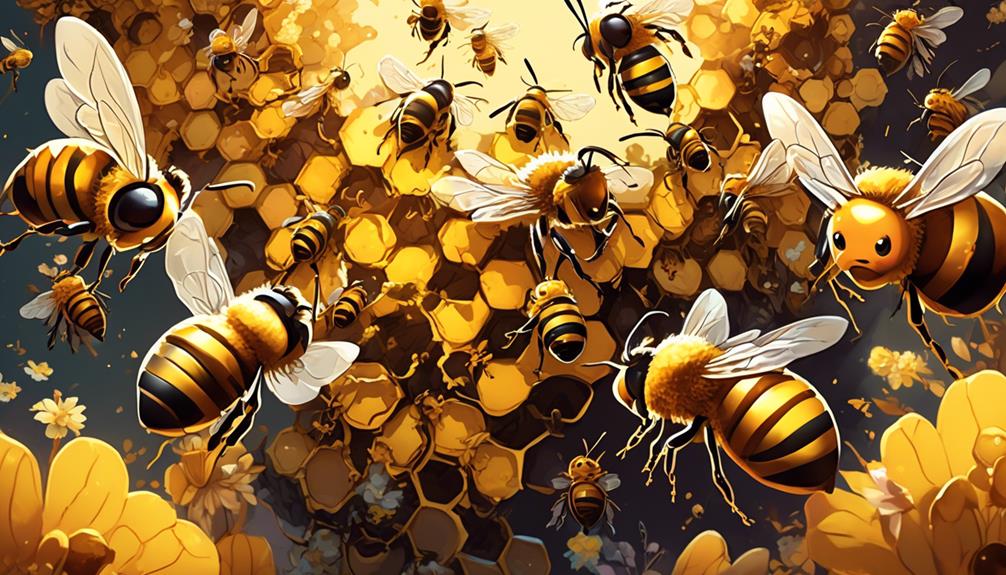Know your buzzers: delve into the intriguing world of bees to discover which have stingers and which ones are harmless.

Which Bees Have Stingers?
Imagine you're out on a sunny afternoon, enjoying a picnic, when a buzzing sound catches your attention. You look around to find a bee hovering nearby, and you're instantly filled with dread thinking about the painful sting it could deliver.
But did you know, not all bees have the ability to sting? Yes, it's true. The world of bees is surprisingly diverse, with around 20,000 known species, and not all are equipped with stingers.
Now, wouldn't you want to know which ones could potentially ruin your picnic, and which ones are harmless?
Key Takeaways
- Bees have a three-sectioned body: head, thorax, and abdomen, with the stinger located in the abdomen.
- The stinger serves the purpose of defense and communication, injecting venom into threats and releasing pheromones to alert other bees.
- Different bee species have variations in their stingers, such as honeybees having barbed stingers that remain lodged in the target, while bumblebees have smooth stingers that can be used multiple times.
- Some bee species, like stingless bees, do not have functional stingers but use other defense mechanisms such as biting or releasing defensive chemicals.
Understanding Bee Anatomy

Diving into the world of a bee's anatomy, you'll find it's a fascinating, intricate system designed for survival and pollination. You'll observe a bee's body divided into three primary sections: the head, thorax, and abdomen, each playing a specialized role in the bee's daily life.
The head houses the bee's brain, compound eyes for detecting light and movement, and antennae for picking up chemical signals. It's also where you'll find the proboscis, a long, straw-like tongue used for sipping nectar.
The thorax, the bee's power center, contains the flight muscles and six legs, each equipped with pollen-gathering tools.
The abdomen, often the most notable section, is where you'll discover the bee's stinger. It's not just a weapon; it's a complex apparatus with barbs, glands, and muscles. When a bee stings, it can't pull back because the barbs get stuck. It's a self-sacrificing act, as this often results in the bee's death. But the sting isn't pointless; the venom contains an alarm pheromone that alerts other bees to danger. In this way, each bee contributes to the hive's survival, even in its last act.
The Purpose of a Stinger

The bee's stinger, a marvel of biological weaponry, serves a dual purpose that's crucial to the survival of the hive. You see, the stinger isn't merely a tool for self-defense. It also plays a significant role in communication within the bee community.
The defensive purpose of the stinger is probably the most familiar to you. When a bee feels threatened, it uses its stinger as a last resort, injecting venom into the perceived threat. This venom contains a cocktail of proteins and peptides that cause both pain and inflammation.
However, defense is only one side of the coin. When a bee stings, it releases pheromones, chemical signals that alert other bees to danger. This isn't just a simple warning, though. The pheromones released are specific, providing crucial information about the nature and location of the threat. This allows the hive to respond appropriately, whether that means rallying to defend the hive or retreating to safety.
Stinger Variation Among Species

While it's clear that the stinger serves a pivotal role in both defense and communication, it's just as crucial to understand that there's a remarkable variation in stinger structure and function across different bee species.
Let's delve into the Honeybee, known scientifically as Apis mellifera. They possess barbed stingers that remain lodged in the attacked target, ripping out of the bee's abdomen and leading to its death. This structure enables the stinger to continue injecting venom even after detachment.
On the contrary, the Bumblebee (Bombus spp.) has a smooth stinger that can be used multiple times without self-inflicted harm.
Now, consider the stingless bees (Meliponini). As the name suggests, these species lack functional stingers but don't mistake their defenselessness. They produce a biting action or release defensive chemicals for protection.
Finally, let's examine the solitary bees, like the Carpenter Bee (Xylocopa). They possess stingers but are generally non-aggressive, using them as a last resort for defense.
In essence, you can see the significant variation of stingers among bee species. This diversity is a testament to the evolutionary adaptations these insects have undergone, highlighting the complexity and beauty of nature's design.
Notable Stinging Bees

In exploring the vast world of bees, you'll encounter some species that are particularly notorious for their potent stings. Let's delve into three of these species: the Honey Bee, the Africanized Honey Bee, and the Yellow Jacket.
Despite being a source of honey, the Honey Bee is known for its painful sting. Unlike many other species, a Honey Bee's sting is a one-time use, resulting in its death.
The Africanized Honey Bee, often referred to as the "killer bee", has a sting that's similar to the Honey Bee. However, their aggressive nature makes them more likely to attack, leading to multiple painful stings.
The Yellow Jacket, while technically a wasp, is often mistaken for a bee. It possesses a painful sting that it can use repeatedly.
Here's a quick comparison of these notable stingers:
Honey Bee | Africanized Honey Bee | Yellow Jacket | |
|---|---|---|---|
Sting Pain | High | High | High |
Multiple Stings | No | Yes | Yes |
Aggressiveness | Low | High | Medium |
Fatality after Sting | Yes | No | No |
Bee Species Without Stingers

Diving into the realm of stingless bees, you'll discover intriguing species such as the Melipona Bee, the Tetragonisca Angustula, and the Austroplebeia australis, all equipped with a unique defense system that doesn't involve a painful prick.
The Melipona Bee, predominantly found in tropical climates, uses a fascinating approach to deter predators. Instead of stinging, they bite and release a resinous substance that immobilizes their threat.
The Tetragonisca Angustula, on the other hand, known for their aggressive swarming behavior, don't sting but rather use their sheer numbers as an effective deterrent.
Lastly, the Austroplebeia australis, native to Australia, also lacks a stinger. They rely on their strong, robust bodies to push and shove intruders out of their nests. This physical approach seems to work effectively for them in their natural habitat.
How Bees Decide to Sting

Now that we've explored the fascinating world of stingless bees, let's shift our focus to those that do sting, specifically, how and why they decide to use this painful defense mechanism. Bees don't sting just for the sake of it. They sting as a way to protect their colony, and this decision isn't based on whim or chance.
Believe it or not, bees use complex communication systems that involve pheromones, movements, and vibrations to alert the colony of potential threats. It's when these signals are perceived that worker bees, primarily the female ones, take up the task of stinging to protect their queen and hive.
Trigger | Reaction |
|---|---|
Intrusion | Releases alarm pheromones |
Threat to hive | Worker bees mobilize |
Attack on bees | Stinging begins |
Post-sting | Releases more pheromones |
End of threat | Stinging ceases |
Frequently Asked Questions
What Is the Lifespan of a Bee With a Stinger Compared to One Without?
You're curious about the lifespan difference between stinging and non-stinging bees. Well, it's not the presence of a stinger that determines lifespan, but the type of bee.
Worker honeybees, which have stingers, live a few weeks to months. Queen honeybees, also with stingers, can live several years. Male drones, without stingers, live only until they mate.
Can a Bee Still Live After Using Its Stinger?
Yes, you're right to ask. It's not the same for all bees.
For example, honey bees can't survive after stinging because their stingers are barbed and get stuck, causing fatal damage when they fly away.
However, other bees, like bumblebees, don't have this issue. They can sting multiple times without harm to themselves.
Do Bees With Stingers Have Different Behaviors Than Those Without?
Yes, bees with stingers often show different behaviors than those without.
Typically, stinger-equipped bees, like honeybees, are more defensive and may swarm if their hive is threatened. They're also more likely to venture further from the nest to forage.
In contrast, stingless bees tend to be less aggressive, sticking closer to their hives and exhibiting more cooperative behaviors.
Is There a Way to Distinguish a Bee With a Stinger From One Without Just by Looking at It?
Yes, you can often distinguish a bee with a stinger from one without. Bees with stingers typically have a pointed abdomen, while those without tend to have a more rounded end.
However, remember this isn't foolproof. Some bees may tuck their stingers in, making them harder to see. Also, male bees don't have stingers but their abdomen might still appear pointed.
Are There Any Human Activities That Provoke Bees to Use Their Stingers More Frequently?
Yes, certain human activities can provoke bees to sting more frequently. When you make sudden movements, swat at them, or invade their territory, you're more likely to get stung.
Bees also react defensively to strong smells, such as perfumes. Furthermore, they're more aggressive when protecting their hive, so disturbing a bee's nest will likely result in stings.
Always respect their space and move calmly to avoid unwanted encounters.
Conclusion
In conclusion, not all bees are created equal when it comes to stingers. While most possess this defensive tool, some bee species lack them entirely. The stinger's purpose is primarily defense, however, its use varies among species.
Significant stinging bees include honeybees and bumblebees. Ultimately, a bee's decision to sting hinges on perceived threats.
So remember, if you respect their space, they're less likely to sting.



